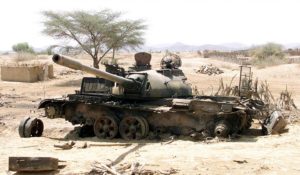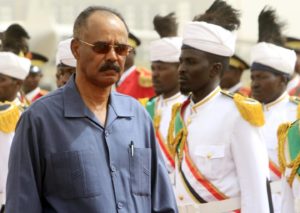- Stay Connected
Who is Isaias Afwerki, Eritrea’s Enigmatic Dictator? By Martin Plaut
In this extract from Understanding Eritrea: Inside Africa’s Most Repressive State, author Martin Plaut reflects on Eritrean President Isaias Afwerki. The president led his people through most of the 30-year war with Ethiopia that culminated in independence in 1993. But the country has never held an election: President Isaias is an absolute ruler without a democratic mandate.
Note: Eritreans are known by their first names, so Isaias Afwerki is known as President Isaias on second reference.
How was it that Eritrea, which won its freedom at such a price, has sunk so far in just over two decades? Once hailed as a beacon of hope for the Horn of Africa, it is now mired in poverty, repression and bitter recriminations with almost all its neighbors. Thousands flee the country every month, braving the Sahara desert and drowning in the Mediterranean, to seek sanctuary on European soil.
The answer can be traced, in good measure, to the personality and policies of one man: Isaias Afwerki. At 70, he has been both the towering figure who led his people to independence and the dictator who now holds them in servitude. Yet, whatever his faults, Isaias has done little to encourage a cult of personality.
Asmara, the Eritrean capital, is not a city littered by his portrait or dominated by North Korean style statues of the “great leader” of the kind that can be found in other African capitals. But Isaias has made such an indelible imprint on his nation that it is impossible to understand Eritrea without grasping something about its president.
Isaias was born on February 2, 1946, in a working class suburb of Asmara. At school he became involved in secret nationalist politics, before leaving to study engineering in the Ethiopian capital Addis Ababa in 1965.
Isaias’s studies did not progress well and he failed his June 1966 exams and had to repeat his year. Without funding for food or lodging it was not a tempting prospect. Isaias decided to leave to join the liberation movement then fighting for Eritrean independence from Ethiopia.
He travelled to eastern Sudan, from where the Eritrean Liberation Front (ELF) was launching attacks inside Eritrea. There he was joined by two friends: Mussie Tesfamikael and Haile Woldetensae, who later became Eritrean foreign minister. Haile, who had been with Isaias at university, described how he was received when he arrived in Sudan in December 1966.
“Isaias was the one who opened the gate—and the first thing he told me was that I have to shut my mouth, that he’s going to tell me a lot of things,” Haile recalls. “I was shocked. What’s happened to this guy? Why is he so afraid?”
The ELF had begun among Eritrean Muslims from the country’s lowlands and had few Christian highlanders like Isaias and Haile in its ranks. They had assumed it was an exemplary revolutionary organisation and were sadly disappointed. Its leadership was poor and sectarian—hostile to the Christians who joined it. Haile described the realisation as “a very dark moment for us.”
To confront this Isaias, Haile and Mussie formed a clandestine cell. Such activity was banned by the ELF and extremely dangerous. To seal their pact the three men took an oath signed in their own blood. They carved an E on their right arms—symbolizing their determination to live or die for Eritrea.
It was an act that marked Isaias out as the kind of driven revolutionary with real leadership potential. Not for him the slow climb through the ranks. Isaias would use secretive structures and personal dedication to take him to the top.
In 1967, Isaias and four others left for China to further their political and military studies. This was at the start of the Cultural Revolution and China was in ferment. President Liu Shaoqi was removed from power. Beaten and humiliated, Liu died in prison two years later. Factions of the Red Guard movement were battling for supremacy on the streets and the country was only saved from anarchy when Mao used the army to restore order.
The young Eritreans must have looked on amazed—but for someone of Isaias’s calibre there was much to grasp. Mao, an authoritarian leader, had turned his society upside down to strengthen his hold on power.
By the time Isaias returned to Sudan in 1968, the ELF was in turmoil. Isaias was sent to be political commissar of his mainly Christian home region, which surrounds Asmara. Isaias was deeply opposed to the religious segregation of the ELF and he joined a reform movement.
Its members were younger, more educated activists—including those who had been trained abroad. Isaias decided to leave the ELF, leading his group into an alliance with other breakaway factions.

Yet away from prying eyes, in the deserts of eastern Eritrea, an even more important event was taking place. This was the founding of a clandestine movement that became known simply as the People’s Party. Founded on April 4 1971, with a secret membership and a Marxist ideology, it would be the instrument through which Isaias would exercise control.
Even at this early stage he did not have things all his own way. Before Isaias could assert his supremacy he had to rebuff internal challenges. His old comrade, Mussie Tesfamikael, led a left-wing faction calling for more radical policies and more open decision-making. Mussie and his supporters met in secret late at night—earning them their nickname: menqa —the bats.
They underestimated Isaias. Denouncing his critics, he put the menqa on trial. The principle of innocent until proven guilty was reversed, becoming guilty until proven innocent. Up to eleven were jailed—some for years. Mussie and a colleague were executed.
Isaias had shown his true colors. Faced with internal challenges he was utterly ruthless, disposing of his closest associates. His supporters should have learnt from this, but few did. Instead, confronted with the exigencies of a long and bitter fight for independence, they rallied behind his charismatic leadership, suppressing concerns about his lack of accountability.
This is the background to the emergence in 1974-75 of the public movement Isaias used to lead the country to independence: the Eritrean People’s Liberation Front. Brave and resourceful, its fighters would trounce the much larger Ethiopian army, despite their foes being armed first by the United States and then the Soviet Union.
It was an extraordinary achievement, which owes much to its president. But he is deeply flawed, with a personality aptly summed up in a leaked diplomatic cable from former U.S. Ambassador Ronald K. McMullen, on March 5, 2009: “Isaias is an austere and narcissistic dictator whose political ballast derives from Maoist ideology fine-tuned during Eritrea’s 30-year war for independence.”
source : News week

